


Sep . 11, 2025 09:20 Back to list
Durable Telescopic Hot Stick for High Voltage Electrical Work
Introduction to Advanced High-Voltage Maintenance Tools
In the demanding world of high-voltage electrical infrastructure, safety and operational efficiency are paramount. The telescopic hot stick represents a critical innovation, empowering technicians to perform live-line maintenance and emergency repairs safely from a distance. This indispensable tool, often referred to simply as a hot stick or a high voltage shotgun stick, is engineered for electrical utility workers, industrial electricians, and contractors who regularly interact with energized electrical systems. Its design prioritizes dielectric strength, mechanical integrity, and ergonomic handling, making it a cornerstone of modern electrical safety protocols. As the energy landscape evolves, the demand for sophisticated, reliable, and versatile hot stick electrical tools continues to grow, adapting to new challenges in transmission, distribution, and industrial power management.
Industry Trends in Live-Line Maintenance and Safety
The electrical utility sector is undergoing significant transformation, driven by advancements in smart grid technologies, renewable energy integration, and increasing demands for network resilience. These trends directly influence the design and application of tools like the telescopic hot stick. Key industry trends include:
- Enhanced Safety Protocols: A continuous push for zero-incident workplaces leads to stricter safety standards and the development of tools with superior insulation, robust locking mechanisms, and integrated voltage detection capabilities.
- Increased Efficiency and Reduced Downtime: Utilities are adopting methods that allow for quicker repairs and maintenance without de-energizing lines, minimizing service interruptions and economic losses. This drives innovation in the versatility and ease-of-use of hot sticks.
- Material Science Advancements: Research into lighter, stronger, and more durable composite materials (e.g., advanced fiberglass reinforced plastics) is improving the performance and longevity of hot sticks, making them more resistant to environmental stressors and mechanical fatigue.
- Digital Integration: While hot sticks are primarily mechanical, future trends may see integration with IoT sensors for environmental monitoring or tool usage tracking, enhancing data-driven maintenance strategies.
- Ergonomics and User Comfort: With an aging workforce, the design of tools increasingly focuses on reducing physical strain, offering better grip, balanced weight distribution, and intuitive extension/retraction mechanisms.
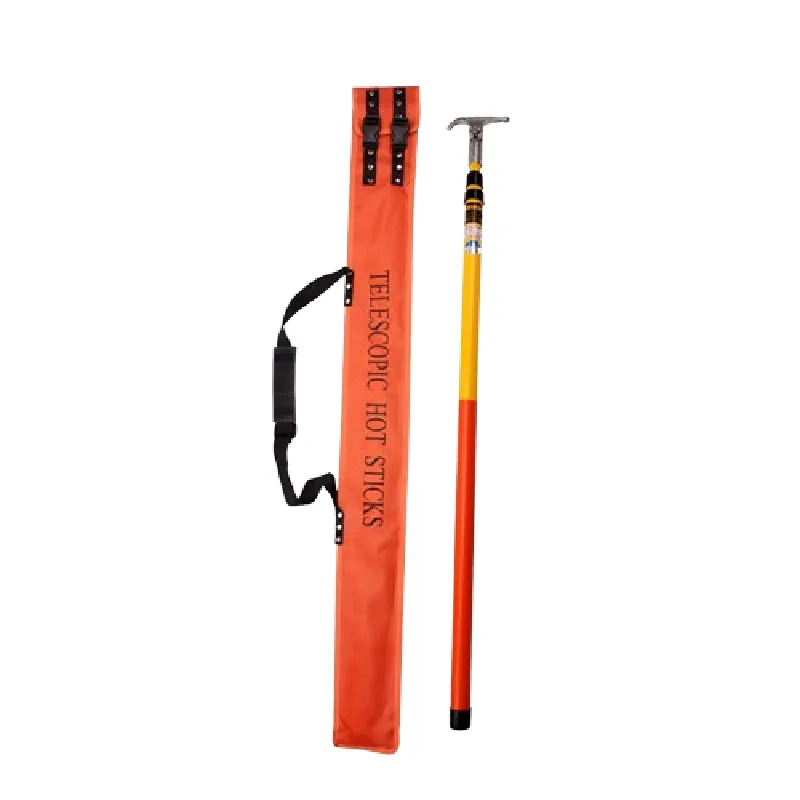
These trends collectively underscore the critical role of specialized tools like the hot stick electrical in ensuring the reliability and safety of power delivery systems.
Technical Specifications of the Telescopic Hot Stick
The design and construction of a telescopic hot stick are governed by stringent technical specifications to ensure maximum safety and operational efficacy. Key parameters include:
- Material Composition: Typically manufactured from high-grade fiberglass reinforced epoxy resin, providing superior dielectric strength and mechanical stability. This composite material is specifically chosen for its insulation properties and resistance to environmental degradation.
- Dielectric Strength: Critical for insulating personnel from high voltages. Hot sticks are rated for specific voltage levels, often exceeding standard operational voltages by a significant margin as per ANSI/IEC standards. For instance, a common rating might be 100 kV per foot of insulating section.
- Extended Length: Ranging from 10 feet to over 50 feet (3m to 15m), allowing access to conductors and equipment at various heights and distances. The telescopic design facilitates compact storage and easy deployment.
- Retracted Length: Essential for transport and storage, typically between 4 to 8 feet (1.2m to 2.4m), depending on the maximum extended length.
- Weight: Optimized for portability and ease of handling, usually ranging from 5 to 25 lbs (2.3 kg to 11.3 kg), varying with length and number of sections.
- Locking Mechanism: Advanced positive locking systems (e.g., button locks, external lock mechanisms) ensure secure section extension and prevent accidental collapse during operation.
- End Fittings: Universal spline or threaded adapters for attaching a variety of tools, such as disconnect heads, fuse pullers, conductor lifters, and voltage detectors.
- Environmental Resistance: Designed to withstand UV radiation, moisture, chemical exposure, and extreme temperatures, ensuring long-term durability in outdoor environments.
Typical Product Specification Table
| Parameter | Value/Description | Standard |
|---|---|---|
| Material | High-grade Fiberglass Reinforced Epoxy Resin | IEC 60855, ASTM F711 |
| Voltage Rating | Up to 500 kV (Insulating strength > 100 kV/ft) | ANSI/OSHA |
| Extended Length | 4.5m to 15m (15 ft to 50 ft) | Manufacturer Specific |
| Retracted Length | 1.5m to 2.4m (5 ft to 8 ft) | Manufacturer Specific |
| Weight | 2.5 kg to 12 kg (5.5 lbs to 26.5 lbs) | Manufacturer Specific |
| Locking Mechanism | Positive Lock (e.g., Button or External Lever) | ANSI F711 |
| Operating Temperature | -30°C to +50°C (-22°F to +122°F) | IEC 60855 |
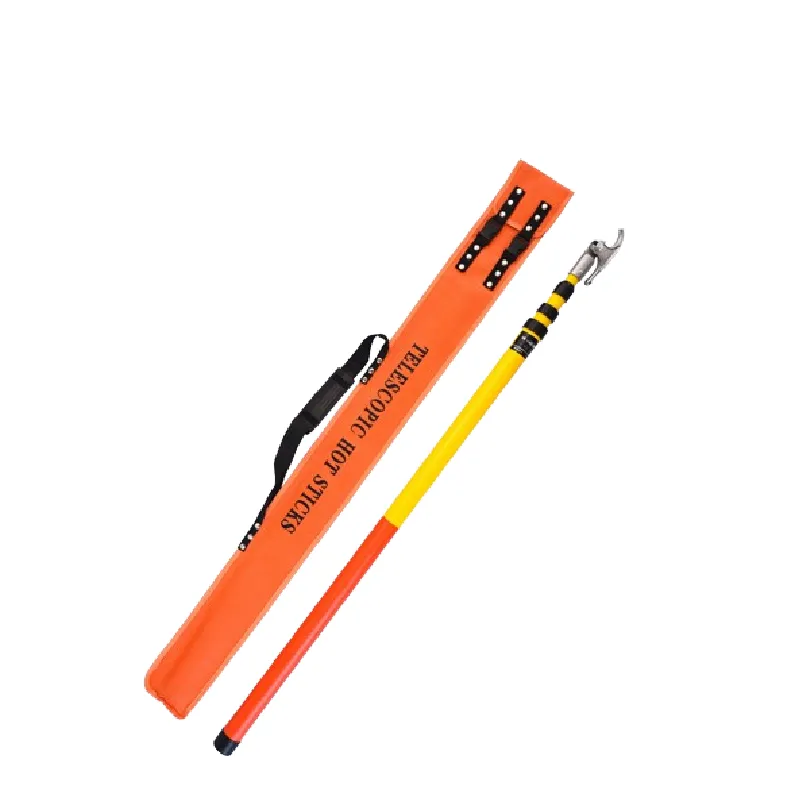
Manufacturing Process and Quality Assurance for Hot Sticks
The production of a high-quality telescopic hot stick involves a meticulous manufacturing process, ensuring both superior dielectric properties and robust mechanical strength. Adherence to international standards is critical throughout.
Process Flow:
- Material Selection and Preparation: High-quality E-glass or S-glass fibers are selected for their excellent strength-to-weight ratio and electrical insulation properties. These are impregnated with specialized epoxy resins designed for high dielectric strength and UV stability.
-
Pultrusion or Filament Winding:
- Pultrusion: Resins are pulled through a heated die, curing the composite material into continuous profiles (tubes or rods) with precise dimensions. This process ensures consistent fiber alignment and material density.
- Filament Winding: Resin-impregnated fibers are wound onto a mandrel in specific patterns, then cured. This method is often used for hollow structures, providing exceptional strength and fatigue resistance.
- Curing and Post-Curing: The pultruded or wound sections undergo controlled heat treatment to fully cure the epoxy resin, optimizing its mechanical and electrical properties.
- Machining and Finishing: Sections are cut to length, ends are machined for precise fit, and surfaces are sanded or coated to achieve a smooth finish that resists moisture ingress and improves handling.
- Component Integration: Locking mechanisms, universal splines, end caps, and handle grips (often made from impact-resistant polymers or CNC machined aluminum for robust attachment) are assembled onto the composite sections.
- Dielectric Testing: Each section and the assembled hot stick undergo rigorous electrical testing, including AC/DC withstand voltage tests and leakage current measurements, to confirm compliance with industry standards.
- Mechanical Testing: Load tests, bend tests, and fatigue tests are conducted to ensure the hot stick can withstand operational stresses and maintain structural integrity over its service life.
- Final Inspection and Certification: A comprehensive visual inspection, dimensional checks, and documentation review are performed before certification (e.g., ISO 9001 for quality management, ANSI A92.2 for dielectric testing, IEC 60855 for live working tools).
Target Industries and Advantages: These robust manufacturing processes ensure that the high voltage shotgun stick is ideally suited for a wide range of critical industries.
- Petrochemical: High resistance to corrosive chemicals and hazardous environments, ensuring longevity and safety.
- Metallurgy: Durability in high-temperature settings and protection against arc flash in heavy industrial power systems.
- Water Supply & Drainage: Corrosion resistance against moisture and various water treatments, critical for pumping stations and control systems.
- Energy Sector (Utilities): Essential for live-line maintenance, reducing outages and ensuring grid reliability, contributing to overall energy saving by minimizing power interruptions.
The typical service life for a well-maintained hot stick can range from 10 to 20 years, depending on usage frequency, environmental conditions, and adherence to proper care and testing schedules.
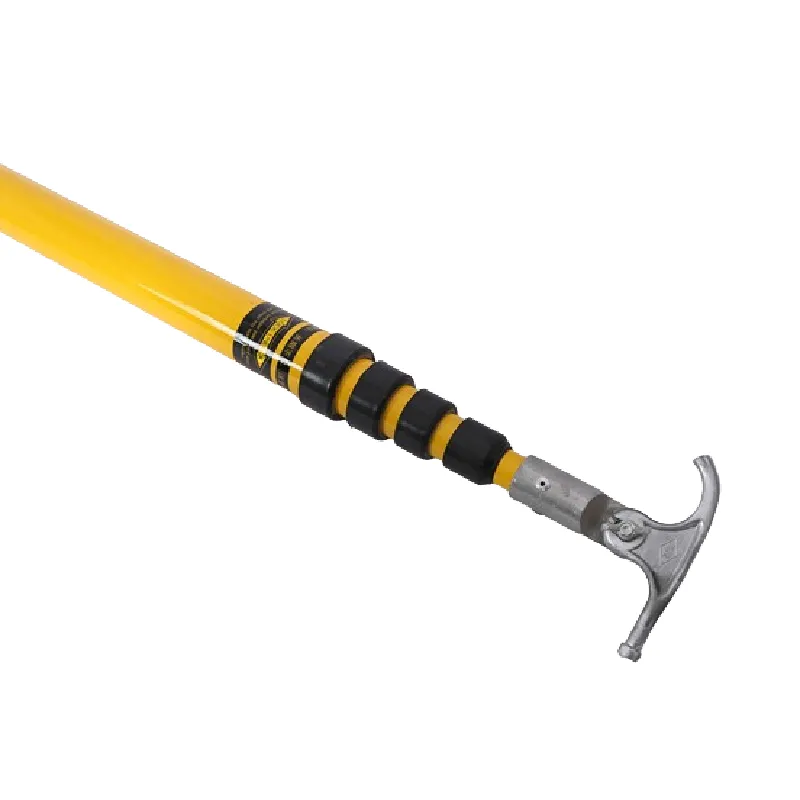
Versatile Application Scenarios for the Telescopic Hot Stick
The adaptability and robust safety features of a telescopic hot stick make it indispensable across a multitude of high-voltage application scenarios. Its primary function is to safely extend a worker's reach into an energized environment, providing critical insulation and enabling precision tasks.
- Live-Line Maintenance on Overhead Power Lines: Technicians can operate disconnect switches, replace fuse cutouts, or install temporary grounds without de-energizing the circuit. This significantly reduces outage times and maintains grid reliability.
- Substation Operations: Used for routine inspections, operating switchgear, or retrieving foreign objects from energized bus bars and insulators, minimizing the need for full substation shutdowns.
- Industrial Plant Electrical Systems: Essential for maintenance in high-voltage industrial distribution networks, such as those found in manufacturing, mining, and chemical processing facilities, where a hot stick electrical ensures safe operation of large circuit breakers and switches.
- Emergency Response: During storm damage or other emergencies, a hot stick allows first responders to safely clear downed lines or isolate damaged sections from a safe distance, preventing further hazards.
- Transformer and Capacitor Bank Maintenance: Facilitates the safe opening and closing of transformer taps, replacing fuses on capacitor banks, or performing voltage checks.
- Insulator Washing: Specialized attachments allow for high-pressure washing of contaminated insulators, restoring their dielectric performance without interrupting service.
In each of these scenarios, the telescopic hot stick enhances operational efficiency by minimizing service interruptions and, most importantly, provides an essential layer of safety, protecting personnel from potential electrocution or arc flash incidents.
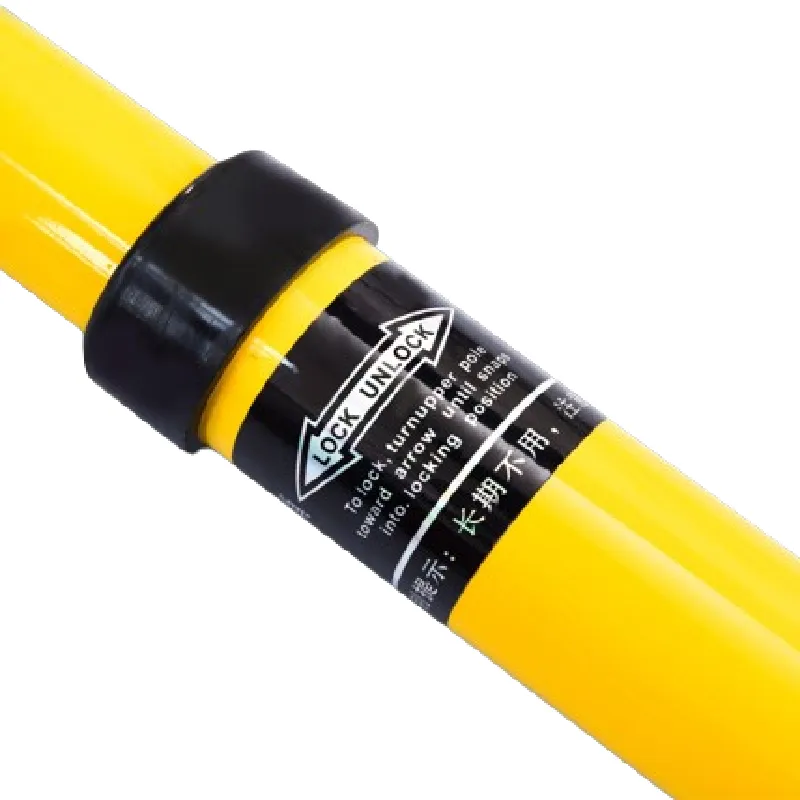
Technical Advantages and Innovations
The modern telescopic hot stick offers significant technical advantages over traditional fixed-length tools or older designs, fundamentally enhancing safety, versatility, and operational efficiency for high-voltage work.
- Variable Reach and Compact Storage: The primary advantage is its ability to extend to various lengths, offering unparalleled flexibility for different tasks and heights. When retracted, it becomes compact and easily transportable, a stark contrast to multiple cumbersome fixed-length hot sticks.
- Superior Dielectric Properties: Utilizing advanced fiberglass-reinforced epoxy resins, these sticks offer exceptional insulating capabilities, often exceeding 100kV per foot (30cm), as required by international standards like IEC 60855 or ANSI/ASTM F711. This minimizes the risk of current leakage and ensures maximum operator safety.
- Advanced Locking Mechanisms: Modern designs incorporate positive locking systems (e.g., button locks, lever locks) that provide secure section extension and retraction, preventing accidental collapse or slippage during critical operations. This enhances both safety and precision.
- Enhanced Durability and Environmental Resistance: Coatings and material treatments provide excellent resistance to UV degradation, moisture ingress, and chemical exposure. This extends the service life and maintains insulating integrity in harsh outdoor environments.
- Ergonomic Design: Lighter materials, balanced weight distribution, and non-slip grips reduce operator fatigue and improve handling, particularly during extended operations or in challenging conditions. The smooth action of telescopic sections further contributes to ease of use.
- Versatile Tool Attachments: A standardized universal spline or threaded end fitting allows for quick and secure attachment of a wide array of specialized tools, transforming a single shotgun stick into a multi-functional device capable of performing various tasks from a distance.
- Reduced Inventory: Instead of stocking multiple fixed-length hot sticks, a single telescopic unit can cover a broad range of required lengths, simplifying inventory management and reducing storage space.
These innovations collectively position the hot stick as an indispensable tool for modern electrical maintenance, significantly improving safety standards and operational efficiency in high-voltage environments.

Vendor Comparison and Selection Criteria for Hot Sticks
Selecting the right telescopic hot stick involves careful consideration of several factors, as different vendors offer varying levels of quality, features, and support. A comprehensive evaluation ensures that the chosen product meets specific operational needs, safety standards, and budget constraints.
Key Comparison Factors:
- Certifications and Compliance: Verify adherence to international and regional safety standards (e.g., ANSI/ASTM F711, IEC 60855, OSHA, ISO 9001). Reputable vendors will openly provide certification documentation.
- Material Quality and Construction: Evaluate the type of fiberglass (E-glass vs. S-glass), resin system, and manufacturing process (pultrusion, filament winding). Higher quality materials ensure better dielectric strength and durability.
- Locking Mechanism Reliability: Assess the ease of operation and security of the locking system. A robust, positive lock is critical for preventing accidental retraction and ensuring operator safety.
- Ergonomics and Weight: Consider the hot stick's balance, grip design, and overall weight, especially for extended use. Lighter, well-balanced designs reduce operator fatigue.
- End Fitting Versatility: Ensure compatibility with a wide range of standard universal spline or threaded tools.
- Customer Support and Warranty: Look for vendors offering strong technical support, readily available spare parts, comprehensive warranty policies, and clear service life guidance.
- Reputation and Experience: Established vendors with a long history in the utility sector often provide more reliable products and better long-term support.
Generic Vendor Comparison Table:
| Feature | Vendor A (e.g., Bilopowtel) | Vendor B (Competitor Example) | Vendor C (Competitor Example) |
|---|---|---|---|
| Material Quality | High-grade S-glass, UV-resistant epoxy | Standard E-glass, good epoxy | E-glass, basic epoxy |
| Voltage Rating (Max) | 500 kV | 345 kV | 230 kV |
| Locking Mechanism | Positive Button Lock with Redundancy | Standard Friction Lock | Basic Cam Lock |
| Weight (15m/50ft model) | ~10 kg (22 lbs) | ~13 kg (28 lbs) | ~15 kg (33 lbs) |
| Certifications | ANSI/ASTM F711, IEC 60855, ISO 9001 | ANSI/ASTM F711 | Internal QA |
| Warranty | 5 Years (Limited) | 2 Years (Limited) | 1 Year |

Customized Solutions for Specialized Applications
While standard telescopic hot stick models meet the needs of many applications, certain specialized operational environments or unique engineering challenges require tailored solutions. Leading manufacturers understand this demand and offer extensive customization capabilities.
Customization options can include:
- Specific Length Requirements: Beyond standard extended and retracted lengths, sticks can be engineered to achieve precise reach capabilities for unique installations or access points.
- Voltage Rating Enhancements: For ultra-high voltage (UHV) applications or environments with extreme transient overvoltages, hot sticks can be designed with enhanced dielectric layers and specialized coatings.
- Specialized End Fittings: While universal splines are common, some applications may require proprietary or highly specialized end fittings for unique tools or equipment interfaces.
- Material Modifications: For extremely corrosive environments (e.g., specific chemical plants, marine applications), specialized composite resins or protective coatings can be applied to enhance resistance beyond standard offerings.
- Integrated Functionality: Custom hot sticks can incorporate integrated features such as non-contact voltage detectors, specific lighting systems, or specialized ergonomic grips designed for prolonged use in particular conditions.
- Color Coding and Branding: For large organizations or specific project requirements, sticks can be color-coded for voltage levels or department use, and branded with company logos.
Engaging with manufacturers that possess deep engineering expertise and a flexible production infrastructure is crucial for developing these bespoke hot stick solutions. This collaborative approach ensures that the final product not only adheres to the highest safety and performance standards but also perfectly addresses the client's specific operational nuances.
Application Case Studies
The practical application of the telescopic hot stick consistently demonstrates its value in improving safety, efficiency, and operational continuity. Here are illustrative case studies:
Case Study 1: Major Utility Company Reduces Outage Times by 30%
A large regional utility company faced persistent challenges with maintaining overhead distribution lines, leading to frequent, short-duration outages. Traditional methods often required de-energizing entire sections, impacting thousands of customers. By integrating a fleet of high voltage shotgun stick tools, equipped with specialized fuse pullers and temporary jumper clamps, their field teams were able to perform live-line fuse replacements and make minor conductor adjustments. This strategic shift resulted in a documented 30% reduction in average outage duration for specific maintenance tasks, significantly boosting customer satisfaction and operational revenue. The ergonomic design also led to fewer reported strain injuries among linemen.
Case Study 2: Industrial Petrochemical Facility Enhances Arc Flash Safety
A major petrochemical complex, operating high-voltage switchgear in a highly corrosive atmosphere, sought to upgrade its arc flash safety protocols. They standardized on advanced hot stick electrical units specifically designed with enhanced chemical resistance and superior dielectric strength. Training programs focused on the safe operation of these tools for routine switching and lockout/tagout procedures. The introduction of these robust hot sticks, coupled with comprehensive training, demonstrably reduced the risk of arc flash exposure to personnel by allowing operations from a greater standoff distance. Moreover, the corrosion-resistant properties of the sticks ensured longer service life, reducing replacement costs compared to previous tools.
Case Study 3: Remote Substation Maintenance in Arid Climates
An energy provider managing remote substations in an arid, dusty region encountered issues with insulator contamination leading to flashovers. De-energizing these critical substations for cleaning was logistically complex and costly. Implementing specialized telescopic hot stick units with high-pressure washing attachments enabled live-line insulator cleaning. This approach not only prevented unscheduled outages but also improved the reliability of power transmission in challenging environmental conditions. The durability of the hot sticks against UV radiation and dust ingress proved vital in this harsh climate.
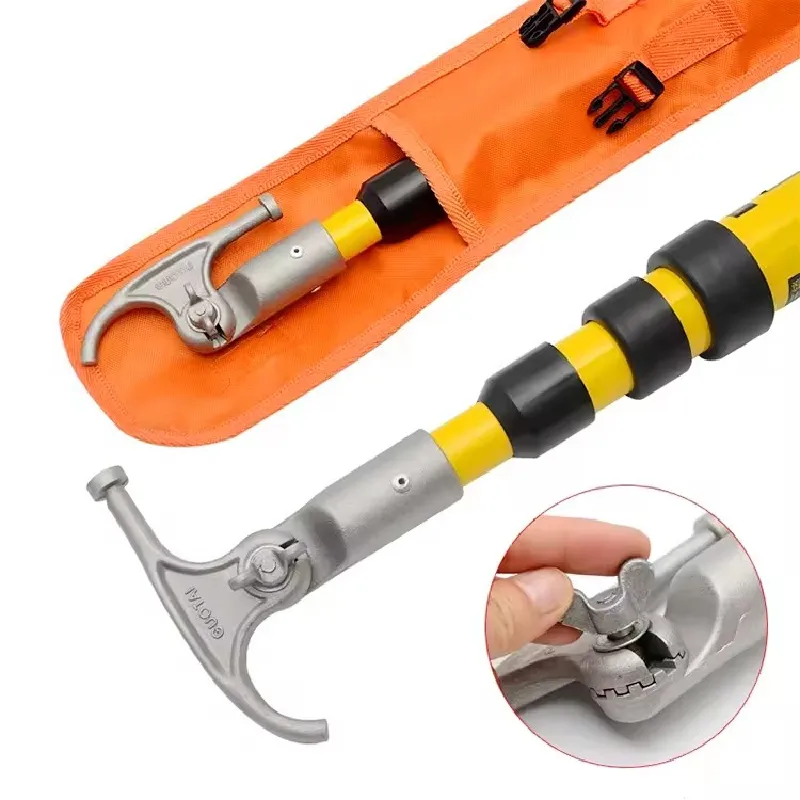
Trust and Support: Ensuring Long-Term Value
Beyond the technical specifications, the trustworthiness of a telescopic hot stick supplier is paramount. This encompasses comprehensive support systems, clear communication, and robust guarantees.
Frequently Asked Questions (FAQ)
Q: How often should a telescopic hot stick be inspected and tested?
A: Regular visual inspections should be performed before each use. Annual electrical re-testing, as per ANSI/ASTM F711 or IEC 60855, is highly recommended and often mandated by safety regulations to verify dielectric integrity.
Q: Can the hot stick be used in wet conditions?
A: While hot sticks are designed to resist moisture, they should ideally be kept dry during use. Water and surface contaminants can significantly reduce dielectric strength. Always consult manufacturer guidelines and local safety regulations for specific conditions.
Q: What is the typical lead time for a custom hot stick order?
A: Standard hot sticks typically have a lead time of 2-4 weeks. Custom orders, depending on complexity and material availability, can range from 6-12 weeks. Specific lead times are always confirmed at the time of order based on current production schedules.
Q: What kind of warranty is offered?
A: Our telescopic hot sticks come with a comprehensive 5-year limited warranty covering manufacturing defects and material failures under normal operating conditions. Detailed warranty terms are available upon request.
Lead Time & Fulfillment
We maintain a robust supply chain and efficient manufacturing processes to ensure timely delivery. Standard orders for the hot stick are typically fulfilled within 10-14 business days, while bulk orders or customized solutions will have lead times communicated transparently during the quotation phase. We prioritize responsive logistics to minimize downtime for our clients.
Warranty Commitments
Our products are built to the highest standards. We offer a 5-year limited warranty on all telescopic hot stick products, covering defects in materials and workmanship. This commitment underscores our confidence in the durability and reliability of our equipment, ensuring peace of mind for our customers.
Customer Support
Our dedicated customer support team is available to assist with product selection, technical inquiries, and after-sales service. We provide comprehensive technical documentation, maintenance guides, and expert advice to ensure the safe and effective use of our hot stick range. Reach out via phone, email, or our online portal for prompt assistance.
Authoritative References
- ANSI/ASTM F711-02(2018) "Standard Specification for Fiberglass-Reinforced Plastic (FRP) Rod and Tube Used in Live Line Tools"
- IEC 60855-1:2016 "Live working - Insulating foam-filled tubes and solid rods for live working - Part 1: Tubes and rods for universal end fittings"
- OSHA 29 CFR 1910.269 "Electric Power Generation, Transmission, and Distribution"
- IEEE Std 516-2009 "IEEE Guide for Maintenance Methods on Energized Power Lines"
- International Organization for Standardization (ISO) 9001:2015 "Quality management systems - Requirements"
Latest news
Hydraulic Crimping Tool – Precision & Heavy-Duty Speed
NewsNov.05,2025
Cable Pulling Swivel | High-Strength, Anti-Twist, Stainless
NewsNov.04,2025
Cable Pulling Tools – Pro-Grade, Safe, Fast Install
NewsNov.03,2025
Hydraulic Crimping Tool – Fast, Precise, Quick-Change Dies
NewsNov.02,2025
Hydraulic Crimping Tool for Sale | Fast, Precise, Heavy-Duty
NewsNov.01,2025
Duct Rodder for Sale – Non-Conductive, Durable Fiberglass
NewsOct.31,2025









